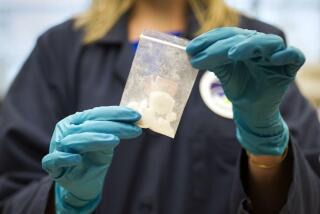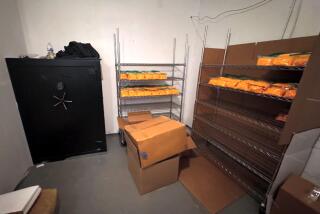âFountain of Youthâ Drug Ring Broken
SAN DIEGO â Taking aim at a booming black market in anti-aging remedies, federal prosecutors on Monday indicted a California family, a German executive and five businesses on 198 charges of smuggling millions of dollars of so-called âfountain of youthâ drugs into the United States.
More than 15 tons of the drugs, made in Europe but not approved for sale in this country, were smuggled into California over the past five years, then repackaged and shipped out to gyms, health food stores and nutritional centers in 43 states and sold as âsupplements,â authorities said.
The distribution of the drugs--pills and injections touted as âcell therapiesâ and âsexual tonicsâ--netted at least $5 million, prosecutors said. The black market in anti-aging remedies has mushroomed into a national industry now worth $2 billion annually, though the drugs do nothing to retard the aging process and may actually be harmful, authorities said Monday.
âThis is health fraud, pure and simple,â Dr. David A. Kessler, commissioner of the Food and Drug Administration, said at a press conference announcing the indictment.
Calling it a âcruel and costly hoax,â Kessler said the smugglers of anti-aging drugs prey upon âthe elderly, the sick and the gullible.â He said the indictment should send âa message to American consumers: If a remedy sounds too good to be true, it probably is.â
In recent years, however, U.S. consumers have been increasingly willing to snap up remedies that promise to turn back the clock.
In announcing the indictment, San Diego prosecutors cited a congressional report asserting that the $2-billion black market is the fastest-growing segment of what the report called a $10-billion-per-year âquackery scandal.â
The black market exists because, under U.S. law, few so-called life-extension products are considered drugs and allowed to be marketed. But demand for the potions are in demand. Most products for sale in health-food stores are labeled as âdietary supplements,â or something similar, experts said Monday.
Movie star Sylvester Stallone admitted a few weeks ago to a publication called Longevity magazine that he takes an anti-aging drug called Gerovital H3. âI inject myself in the butt three days a week for three weeks twice a year,â he said, according to a wire service report of the magazine article.
Stallone could not be reached Monday for comment. His Los Angeles-based publicist declined to comment. Authorities said it is not unlawful to use the products.
Prosecutors said Gerovital H3--on display at the press conference Monday--is derived from a product proven only to be a topical anesthetic.
Also on display Monday were âcell therapies,â chemical substances isolated from the tissues of young sheep or cattle that are promoted for more than 100 medical conditions ranging from acne to sterility, prosecutors said.
FDA officials said these products could lead to a variety of diseases, including even bovine spongiform encephalitis, also known as âmad cow disease.â
Another product on display Monday is called Zumba Forte. Touted as a âstimulant and roborant for men,â it supposedly includes vegetable substances discovered by primitive native inhabitants of tropical jungles.
Prosecutors said Monday it also includes an anabolic steroid, methyltestosterone, whose adverse side effects are well documented.
The indictment alleges that entrepreneur David Halpern, 38, of Pebble Beach, imported huge quantities of Zumba Forte, Gerovital H3 and cell therapies from Germany and England, using sham corporations and mail drops in Southern California registered to fictitious names.
He also allegedly imported a wide variety of other substances, including one identified as âhuman umbilical cord dilution,â said Assistant U.S. Atty. Phillip Halpern, the prosecutor in the case.
âIs that scary stuff or what?â Phillip Halpern said. âWeâre on the border of witchcraft.â
Prosecutor Halpern is no relation to David Halpern.
The scheme ran from 1983 through 1990, when U.S. Customs officials opened a box shipped to San Diego that contained drugs and had been mislabeled âcurtain rods,â Phillip Halpern said.
Through the years, the boxes were also mislabeled as games, toys and glass figurines. On U.S. Customs forms, the value of the boxes were put at only $35 to $85, said Phillip Halpern.
After arrival in the United States, the drugs were repackaged and then shipped to stores. Combined orders to a single customer--not identified Monday--exceeded $400,000, prosecutors said.
Assistant U.S. Atty. Halpern said David Halpern claimed sales of $1 million annually on his tax returns.
Gerovital H3--in tablets--sold for $9.95 for a package of 25, according to the indictment. Zuma Forte was $39.95 for 300 tablets. Ten ampules of cell therapy solution went for $199.95. Two ampules of âhuman umbilical cord dilutionâ cost $39.
Also named in the indictment were David Halpernâs mother, Frances D. Halpern, 65, of San Diego; his sister, Frances H. Wellgood, 37, of Little River, Calif.; her husband, Edward Sollisch, 62, of Little River; and Maximilian Schmidt, 26, of Munich, Germany, president of Zumba GmbH, the firm that makes Zumba Forte.
Besides Zumba GmbH, the other companies named in the indictment are three British firms; and Emanon Inc. of Ft. Bragg.
The smuggling and conspiracy charges carry prison terms ranging from two to five years and fines of $250,000--on each of the 198 counts.
The case was brought in San Diego because mail drops were located locally. In addition, Phillip Halpern is known in national legal circles for his successful prosecutions of steroid traffickers.
Schmidt remains outside the country, prosecutors said Monday. The other four accused surrendered Monday to federal authorities in San Diego and posted bond, prosecutor said.
U.S. Magistrate Leo Papas set bail for David Halpern at $250,000, for Frances H. Wellgood and Edward Sollisch at $100,000 and for Frances D. Halpern at $50,000.
The next hearing in the case is scheduled for March 23 before U.S. District Judge Earl B. Gilliam Jr. in San Diego.
More to Read
Sign up for Essential California
The most important California stories and recommendations in your inbox every morning.
You may occasionally receive promotional content from the Los Angeles Times.










